

Human self-reflection. This penultimate scene of the Admonitions Scroll shows a palace lady sitting in quiet contemplation, presumably following the admonitions in the accompanying lines:[1] "Therefore I say: Be cautious and circumspect in all you do, and from this good fortune will arise.
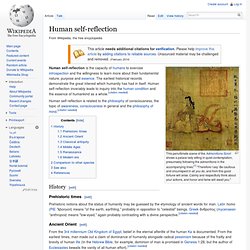
Calmly and respectfully think about your actions, and honor and fame will await you. " Human self-reflection is the capacity of humans to exercise introspection and the willingness to learn more about their fundamental nature, purpose and essence. The earliest historical records demonstrate the great interest which humanity has had in itself. Human self-reflection invariably leads to inquiry into the human condition and the essence of humankind as a whole. [citation needed] Human self-reflection is related to the philosophy of consciousness, the topic of awareness, consciousness in general and the philosophy of mind. History[edit] Prehistoric times[edit] Ancient Orient[edit] Classical antiquity[edit] Middle Ages[edit] The Power of Reflection. There has been much written and researched on the topic of reflection.
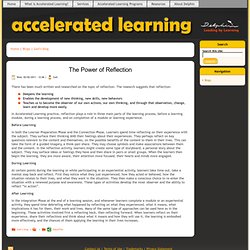
The research suggests that reflection: Deepens the learningEnables the development of new thinking, new skills, new behaviorsTeaches us to become the observer of our own actions, our own thinking, and through that observation, change, learn and develop more easily. In Accelerated Learning practice, reflection plays a role in three main parts of the learning process, before a learning module, during a learning process, and on completion of a module or learning experience.
Before Learning In both the Learner Preparation Phase and the Connection Phase, Learners spend time reflecting on their experience with the subject. Accelerated Learning. Blog Top Sites - Directory of the Best Blog Sites. Teacher Blogs. February 21, 2017 - In the Classroom+ In the Classroom (7) Curriculum Matters Writers Liana Loewus and Jaclyn Zubrzycki explore teaching and learning across the subject areas.
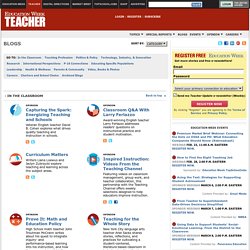
Prove It: Math and Education Policy High School math teacher John Troutman McCrann writes about his quest to integrate inquiry- and performance-based learning into his instruction, and how these concepts might inform education policy. Teaching for the Whole Story. Mortarboard blog. Domestic violence can happen to anyone, including students, writes a blogger.

Photograph: Garry Weaser. Top 100 Education Blogs. Education blogs are becoming a means for educators, students, and education administrators to interact more effectively than ever before.
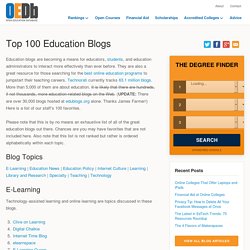
They are also a great resource for those searching for the best online education programs to jumpstart their teaching careers. Technorati currently tracks 63.1 million blogs. Edublogs - education blogs for teachers, students and institutions. 1.

Share materials, news, downloads, links and more Anything that you post to your blog will instantly be accessible by your students from school and from home. What’s more, you can easily manage who gets to access them through passwords and privacy measures. 2. Facilitate online discussions and collaboration Students can simply respond to blog posts and discuss topics through comments or on our simple to use forums. 3. Seamlessly produce a custom designed, finely tuned and engaging collaborative online publication by your class. 4. Digital Media & Learning. Blog. A blog (a truncation of the expression weblog)[1] is a discussion or informational site published on the World Wide Web and consisting of discrete entries ("posts") typically displayed in reverse chronological order (the most recent post appears first).
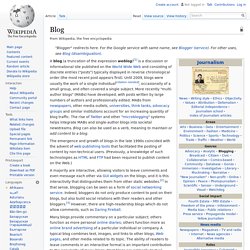
Until 2009, blogs were usually the work of a single individual[citation needed], occasionally of a small group, and often covered a single subject. More recently "multi-author blogs" (MABs) have developed, with posts written by large numbers of authors and professionally edited. MABs from newspapers, other media outlets, universities, think tanks, advocacy groups and similar institutions account for an increasing quantity of blog traffic. The rise of Twitter and other "microblogging" systems helps integrate MABs and single-author blogs into societal newstreams. How Blogs Work" Blogs appear on the news pretty often these days.

For example, a reporter is tipped to a story by a blog, or a blog reports another angle on a story. Blogs show up in magazines a lot, too. But there is a good chance you have never seen a blog (also known as a weblog) or experienced the blogosphere. What are blogs? There are now millions of them -- where did they all come from? One of the things that is so amazing about blogs is their simplicity. Think about a "normal Web site. " A typical Web site has a home page that links to sub-pages within the site. Blogs_cl_web.pdf (application/pdf Object) Prensky - Digital Natives, Digital Immigrants - Part1.pdf (application/pdf Object)
Prensky - Digital Natives, Digital Immigrants - Part2.pdf (application/pdf Object) New research paper on employee Internet use. Blogs making their impact felt. The impact of blogging has reached a tipping point, argues Julian Smith, senior analyst at Jupiter Research.

Anyone studying the media over the last few months might have noticed a sudden increase in concern about the growth of consumer-created content and the impact of blogging on business. What is the impact of blogging? Wikileaks has hit headlines recently for exposure of information.

There is no denying that the cultural phenomenon that is blogging has a big impact on the world.